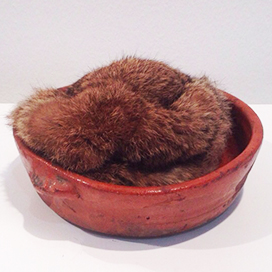
Breathing Object
Günter Weseler

From March 6th to April 3rd, 2020
Via Nassa 3/A | Lugano
Galleria Allegra Ravizza is pleased to present the exhibition of Günter Weseler, Breathing Object, his second solo show in Switzerland, here some works specially created on this occasion are shown.
Günter Weseler, born in Poland in 1930, grew and lives in Düsseldorf. From the very start he has focused his work on the phenomenon of breathing and its relations to our lives. Due to a throat illness, Weseler has always suffered from breathing difficulties that led him to be particularly aware of breathing, functioning of the organs, what can help him better to breathe and, on the contrary, what creates difficulties and effort.
Weseler has learnt to feel his body, his emotions, he has pondered on the different possibilities to control it and find it out. From 1964, genesis of his works on the respiration, two different components of breathing were revealed: the sound and the visible.
The “Atemobjekte”, in English “Breathing Objects”, are the constant evolution of his work and his studies, they have never left him but always accompanied him, evolving during his entire artistic career.
Every “Breathing Object”, nestled in furs, breathes coping a specific feeling and changes its own nature in relation to the space it places. New types of movement arise creating a relation between the rhythm of the breath and the visible movement that it produces, the faint sound, generating sights that are alive in all respects. Beside us.
As Weseler wrote: “The objects change in relation to the environment that surrounds them and in turn modify the environment itself. The observer always understands the object of his observation from his particular point of view, based on his particular past experience, his energy, like a mirror”.
It is precisely from this almost meditative kinetic component intrinsic in his works that the organic and animal elements of the opera emerge, making them alive, as in Ruggero Vasari’s imaginary shown in “L’angoscia delle Macchine” (The Agony of the Machines, 1921-23) or in the movie “Metropolis” directed by Fritz Lang in 1927. We could have seen this close correlation thanks to the researches carried out in the Gallery and shown during our last exhibition titled “Metropolis”, questioning if maybe that particular science fiction strand born in the early XX century from the publication of “L’Angoscia delle Macchine” by R. Vasari -which inspired the famous silent movie “Metropolis”- could have influenced the Weseler’s artistic research in 50’s and 60’s, creating electronic mechanism which in the Weselerian imagery obtain total humanity, their own sensitivity and sometimes an unconscious expression: machines that breathe, live, pulsate and modify the world around us.
Günter Weseler was born in Allenstein, on March 2nd, 1930.
He graduated in Architecture and from 1958 he has worked as self-taught painter and sculptor. In 1960 Weseler inaugurated his first solo show at Utermann Gallery in Dortmund (Germany).
In 1964 he creates the first “Atemmusiken” (or “Breath Music”). Here a series of works based on the phenomenon of breathing translated into music begins and led him to create the series of the “Atemobjeckte” studying the mutation of the relations between them, their own position in the space, the place and the surrounding situation.
In the Eighties his artistic work integrates the “Atemobjecte” with mandala and ritual forms, focusing mostly on the spiritual element. Between 1989 and 1993 Weseler is invited as Professor at Hochschule in Hamburg. The first “Moosobjekt” (Object with moss) and “Mirror-Objects” in which the concrete and virtual elements interact date back to the Nineties.
Weseler’s works are part of different museums and collection, such as: Museum of Art in Düsseldorf, Kunsthalle in Brema, Museum of Contemporary Art in Sydney, Atheneum Museum in Helsinky, Museum of Art in Bern and the Institute of International Relations in Stuttgart.
